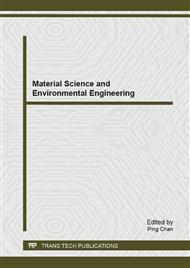[1]
J.R. Easton, B.D. Waters, J.H. Churchley, J. Harrison, in: P. Cooper (Ed. ), Colour in Dyehouse Effluent, Society of Dyers and Colourists, The Alden Press, Oxford, 1995, p.9.
Google Scholar
[2]
J.W. Lee, S.P. Choi, R. Thiruvenkatachari, W.G. Shim, H. Moon, Evaluation of the performance of adsorption and coagulation processes for the maximum removal of reactive dyes, Dyes Pigments 69 (2006) 196–203.
DOI: 10.1016/j.dyepig.2005.03.008
Google Scholar
[3]
M.R. Sohrabi, M. Ghavami, Photocatalytic degradation of Direct Red 23 dye using UV/TiO2: effect of operational parameters, J. Hazard. Mater. 153 (2008)1235–1239.
DOI: 10.1016/j.jhazmat.2007.09.114
Google Scholar
[4]
J.S. Wu, C.H. Liu, K.H. Chu, S.Y. Suen, Removal of cationic dye methyl violet 2B fromwater by cation exchange membranes, J. Membr. Sci. 309 (2008) 239–245.
DOI: 10.1016/j.memsci.2007.10.035
Google Scholar
[5]
Banat, I.M., Nigam, P., Singh, D., Merchant, R., 1996. Microbial decolorization of textile dye containing effluents: a review. Bioresour. Technol. 58, 217-227.
DOI: 10.1016/s0960-8524(96)00113-7
Google Scholar
[6]
Shamik Chowdhuru, Rahul Mishra, Papita Saha, Praveen Kushwaha, Adersoption thermodynamics, kinetics and isosteric heat of adsoption of malachite green onto chemically modified rice husk, Desalination 265 (2011) 159-168.
DOI: 10.1016/j.desal.2010.07.047
Google Scholar
[7]
W.T. Tsai, H.R. Chen, Removal of malachite green from aqueous solution using low-cost chlorella-based biomass, J. Hazard. Mater. 175 (2010) 844-849.
DOI: 10.1016/j.jhazmat.2009.10.087
Google Scholar
[8]
Q. Zhou, W.Q. Gong, C.X. Xie, D.J. Yang, X.Q. Ling, X. Yuan, S.H. Chen, X.F. Liu, Removal of Neutral Red from aqueous solution by adsorption on spent cottonseed hull substrate, J. Hazard. Mater. 185(2011)502-506.
DOI: 10.1016/j.jhazmat.2010.09.029
Google Scholar
[9]
Park, D., Yun, Y., Park, J.M., 2006. Comment on 'Chromate ion adsorption by agricultural by-products modified with dimethyloldhydroxylethylene urea and choline chloride, by Wartelle and Marshall. Water Res. 40, 1501–1504.
DOI: 10.1016/j.watres.2005.12.029
Google Scholar
[10]
T. Vaughan, C.W. Seo, W.E. Marshall, Removal of selected metal ions from aqueous solution using modified corncobs. Bioresour. Technol. 78 (2001) 133-139.
DOI: 10.1016/s0960-8524(01)00007-4
Google Scholar
[11]
R. Leyva-Ramos, L.A. Bernal-Jacome, I. Acosta-Rodriguez, Adsorption of cadmium(II) from aqueous solution on natural and oxidized corncob, Sep. Purif. Technol. 45 (2005) 41-49.
Google Scholar
[12]
C.W. Cheung, J.F. Porter, G. McKay, Sorption kinetic analysis for the removal of cadmium ions from effluents using bone char, Water Res. 35 (2001) 605-612.
DOI: 10.1016/s0043-1354(00)00306-7
Google Scholar
[13]
G. Bayramoglu, A. Denizli, S. Bektas, M.Y. Arica, Entrapment of Lentinus sajor-caju into Ca-alginate gel beads for removal of Cd(II) ions from aqueous solution: preparation and biosorption kinetics analysis, Microchem. J. 72 (2002) 63-76.
DOI: 10.1016/s0026-265x(01)00151-5
Google Scholar
[14]
Y.S. Ho, G. McKay, Pseudo second order model for sorption process, Process Biochem. 34 (1999) 451-465.
DOI: 10.1016/s0032-9592(98)00112-5
Google Scholar
[15]
V. Vadivelan, K.V. Kumar, Equilibrium, kinetics, mechanism, and process designfor the sorption of methylene blue onto rice husk, J. Colloid Interf. Sci. 286 (2005) 90–100.
DOI: 10.1016/j.jcis.2005.01.007
Google Scholar
[16]
I. Langmuir, The adsorption of gases on plane surfaces of glass, mica and platinum, J. Am. Chem. Soc. 40 (1918) 1361–1403.
DOI: 10.1021/ja02242a004
Google Scholar
[17]
M. Kilpatrick, L.L. Baker Jr., C.D. Mckinney Jr., Studies of fast reactions which evolve gases, The reaction of sodium-potassium alloy with water in the presence and absence of oxygen, J. Phys. Chem. 57 (1953) 385–390.
DOI: 10.1021/j150505a001
Google Scholar
[18]
V.J.P. Vilar, C.M.B. Botelho, R.A.R. Boaventura, Methylene blue adsorption by algal biomass based materials: biosorbents characterization and process behaviour, J. Hazard. Mater. 147 (2007) 120–132.
DOI: 10.1016/j.jhazmat.2006.12.055
Google Scholar


